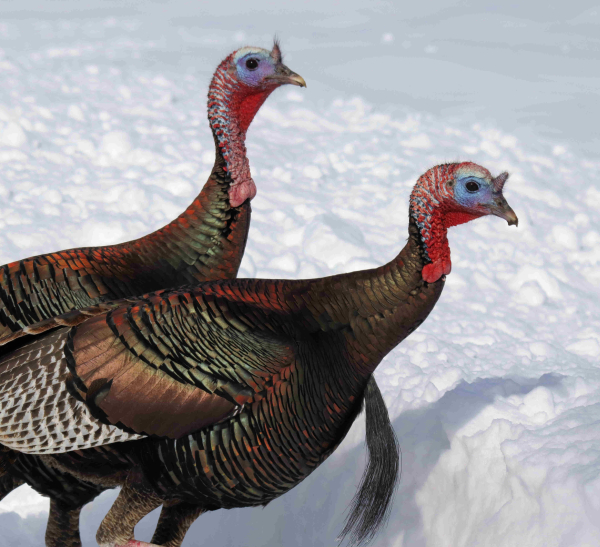
On a day when bird sightings were in short supply, a flock of Wild Turkeys provided some nice portraits of mature toms.
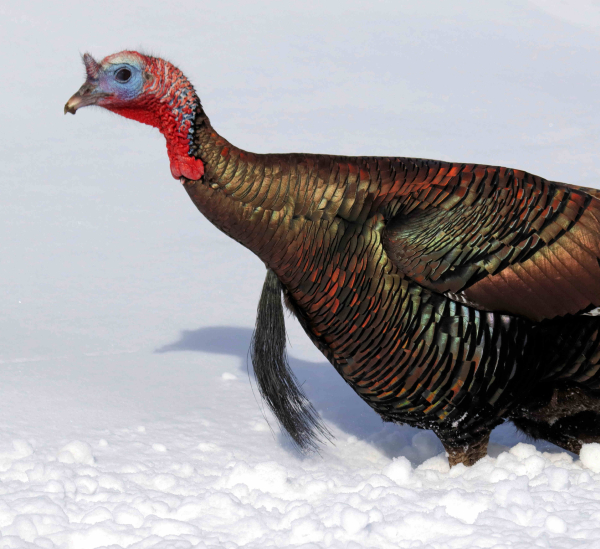
Offset by new snow, the iridescent colors of the plumage of Wild Turkeys along with their varicolored bare skin shined brightly in the afternoon sunlight.
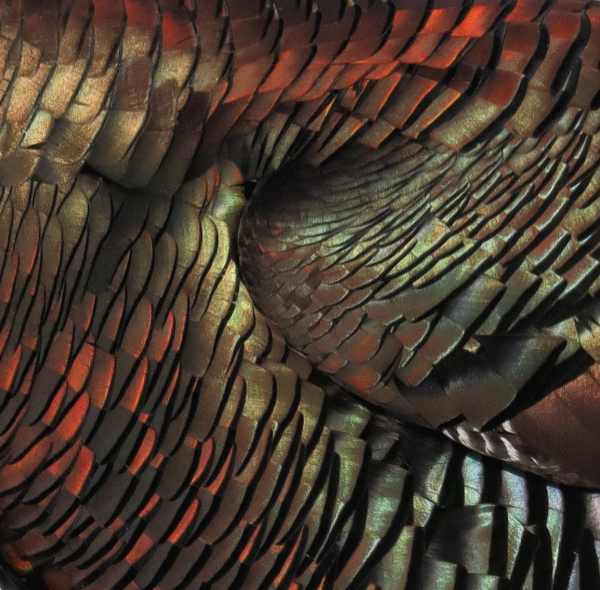
A closer look at the overlapping feathers and iridescent colors highlighted by the sun.
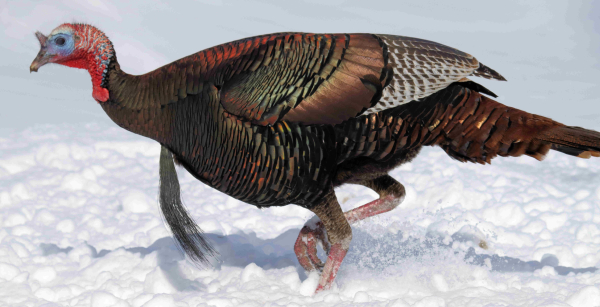
The long “beards” of the adult males are actually modified feathers.
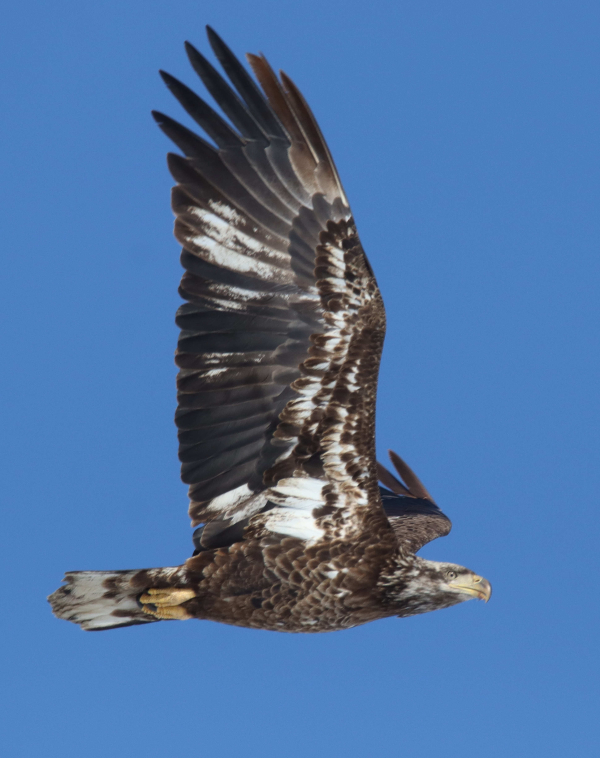
The massive wing loading of this young female Bald Eagle is impressive. Considering its body feathers are almost uniformly brown, its head and tail feathers are molting toward white, and its eyes and beak are turning yellow, this is a 4th year immature Bald Eagle nearing adult status.
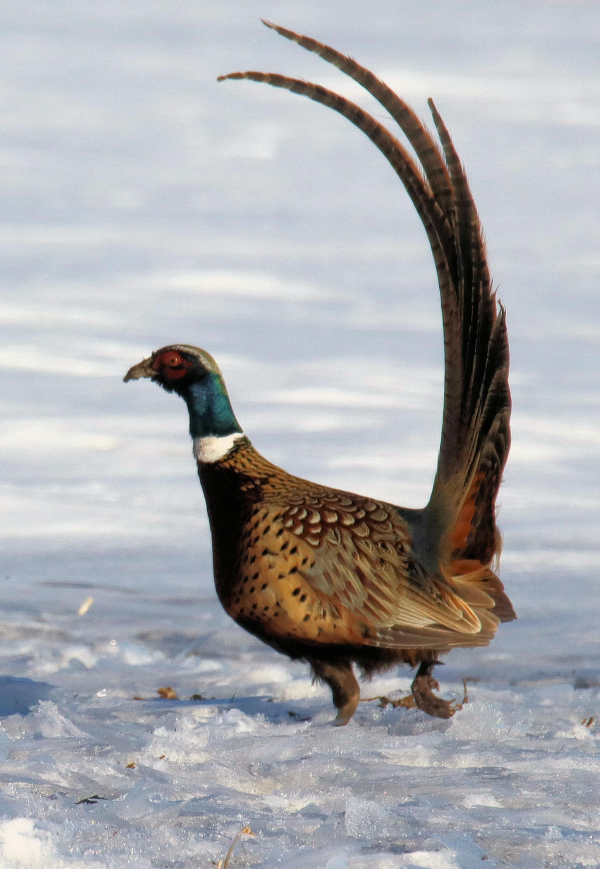
A gust of wind caught the especially long tail feathers of an older male Ring-necked Pheasant, blowing the tail feathers high above its head and even curving feather tips forward.
|
A paucity of birds across the plains made a hunting Merlin stand out as it sliced low east of Bismarck, which elevated my alert level as the sunlight broke through passing clouds Thursday. But not another bird showed until I headed south of town with my pizza burger flying-style from the Big Boy drive-in. A flock of Wild Turkeys foraging in the riverbottom woodlands gave me a chance to position for some photos. The landscape was covered with more than a foot of new snow after the big snowfall Tuesday night. The turkeys provided so much camera fun that after leaving them, I had to circle back, which was fruitful as I was able to get even better images during a second photo session.
Sand Lake Query
With yet another snowstorm on the way, Saturday’s sunny afternoon made me want to explore a bit with birdy signs of spring in mind. Three Sharp-tailed Grouse were the first birds aside from the abundant flocks of Horned Larks sprinkled with a few Snow Buntings. A pair of Bald Eagles, definitely a male and a female, were perched in the familiar lone cottonwood about 25 miles southeast on the way to Sand Lake National Wildlife Refuge. I hoped there might be more eagles in the vicinity of the South Dakota refuge, and they would be a good indicator that the earliest migrants were breaking through the exceptionally late winter weather. I didn’t see other birds of note until I entered the Sand Lake realm – within about 5 miles of the grand refuge complex along the extensive marshes fed by the James River.
First bird was a winging second-year Bald Eagle that I would have appreciated intercepting, its light coloring making it an attractive photo subject. A couple miles closer to the refuge a hawk was feeding on a road-killed pheasant, providing a rather distant photo op as I didn’t want to scare the raptor from its newfound food. But what kind of hawk? It offered a difficult ID until it took flight, making it all too obvious it was a fine Rough-legged Hawk. I haven’t seen a Rough-leg on the north side of the border between the Dakotas – just 20 miles away – so this was a potential early migrant, just as the eagles might be early migrants.
Next was an adult Bald Eagle, followed by a 4th-year Bald Eagle, and an immature Bald Eagle – I thought. The supposed immature eagle, perched on the edge of the expansive frozen and snow-covered marsh, demanded a second look, and as I raised my binoculars I realized it was a Golden Eagle. Taking flight, it also revealed it was an adult; and this was the first Golden Eagle I’ve ever seen during so many visits to Sand Lake Refuge.
Still no photos though, but suddenly a young Bald Eagle appeared to my left in full sunlight, a little too high, and flying a little too fast. But I managed to get into position as best I could as the big female sailed by on expansive wings. With only about 3 seconds elapsing, I managed to take 5 photos of the impressive eagle on the wing. Reviewing the images, only one was really sharp, but it was an exceptional photo of the eagle that shows its massive wing load and revealing it was molting into its 4th year plumage with its body fathers quite uniformly brown, its head and tail becoming white, and it’s eyes and beak turning yellow – what a bird!
That was the last of the 7 eagles I encountered, but that’s when the Ring-necked Pheasants took over as I turned south along the west side of the refuge. After seeing 2 flocks of 5 each in North Dakota, I’m sure I observed more than 100 along this stretch of South Dakota, including a flock of more than 30 and another with 16. I photographed several pheasants, and my favorite image was taken when a gust of wind caught the especially long tail feathers of an older male, blowing the tail feathers high above its head and curving feather tips forward. One more raptor completed the day’s list, a male American Kestrel – an early migrant or a wintering bird?
Closer to Home
Friday, I appreciated the 2 newest visitors to my feeders – a Red-breasted Nuthatch and a female Downy Woodpecker that have been regular over the past 2 weeks. Then a new male Hairy Woodpecker stopped in for a shelled peanut, a species I haven’t seen since January. Saturday morning a new male Downy Woodpecker stopped by so there were some nice changes happening it seemed. White-breasted Nuthatches and House Finches rounded out the feeding station regulars, and although I sometimes hear Blue Jays in the area, they don’t raid my feeding station, although they are favorite winter visitors.
After a winter of high snowfall, which escalated recently with 3 big snowstorms within 9 days, there is sooo much snow in my yard and far beyond across this wetland-rich area. If the snow ever melts, it’s going to attract sooo much attention from migrating and nesting birds, especially among a variety of ducks, shorebirds, pelicans, gulls, and terns. For now, birds are especially few and far between, but as I wrote this, I checked out the Rowe Audubon Center’s live cam on the central Platte River of Nebraska, just 2 states south, and there is an abundance of Northern Pintails, Mallards, Sandhill Cranes, Snow Geese, and Canada Geese – the migration northward has reached Nebraska – they are halfway here! (see Audubon's Rowe Sanctuary's Crane Camera | Explore.org) Enjoy the birds around you, and keep an eye out for signs of spring – daylight savings time begins this weekend.
Article and photos by Paul Konrad
Share your bird sightings and photographs at editorstbw2@gmail.com